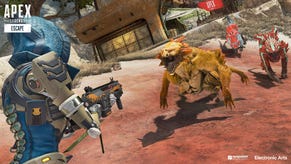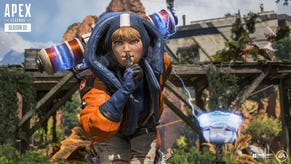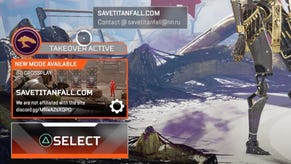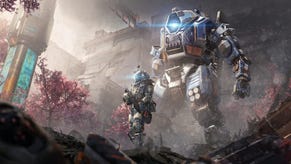Titanfall 2 PS4 Review: Mech Friends
After two and a half years in development, expectations are high for Respawn's second release.
This article first appeared on USgamer, a partner publication of VG247. Some content, such as this article, has been migrated to VG247 for posterity after USgamer's closure - but it has not been edited or further vetted by the VG247 team.
Respawn's Titanfall was generally well received by players and critics alike when it was released in March of 2014, although many felt that the game's lack of bespoke single-player campaign was a glaring omission. That's certainly not the case with the sequel: Titanfall 2 features a full single-player campaign to accompany its beefed-up multiplayer component.
It's the story of a hero's ascension from humble beginnings. Jack Cooper is a grunt rifleman in the Frontier Militia who's fortunate enough to find himself under the tutelage of veteran pilot Captain Lastimosa. The campaign kicks off with Lastimosa taking Jack through the basics of pilot maneuverability in a simulated training mission. It's an effective opening to the game that quickly brings you up to speed on Titanfall 2's fairly comprehensive, but intuitive parkour-like movement system that incorporates double-jumping, wall-running, sliding, and auto-mantling over objects and hazards. That's assuming you actually need to be brought up to speed, of course. If you've played Titanfall, you'll immediately feel right at home, because Titanfall 2's control scheme is fundamentally the same as it was in the original game, barring a few refinements in terms of the seamlessness of chaining together moves.
Before the training can go any further, Cooper and Lastimosa are called into action: An attack on the Interstellar Manufacturing Corporation-occupied planet of Typhon is being prepared, and the pair say their goodbyes as they go about their designated duties. Things don't go well, however, and the transport ship they're both aboard is attacked, badly damaged, and crash-lands on Typhon.
Cooper regains consciousness on the planet's surface. Bodies of his dead comrades litter the ground, and the planet's indigenous carnivores are already beginning to fight over the bones of the deceased. Close by, he finds one survivor – Captain Lastimosa. However, his mentor is not in good shape, and as he draws his last few breaths, he relinquishes command of his vanguard model titan, BT-7274, to Cooper, who takes Lastimosa's helmet and uplinks with BT, forming a connection with the titan.
BT tells Cooper that he's almost out of power. Fortunately, there's a replacement battery in the wreckage of the ship nearby. Reaching it involves negotiating a river-cut ravine, whose steep sides and jutting rocks conveniently offer plenty of wall-running and double-jumping opportunities. The action at this juncture is essentially a platform game – mechanics that are repeated throughout Cooper's adventure in increasingly complex and labyrinthine forms. Early on, though, the going is quite straightforward, and in the unlikely event that you need help, BT can always scan the environment and send out a ghost trace to show you the way forward.
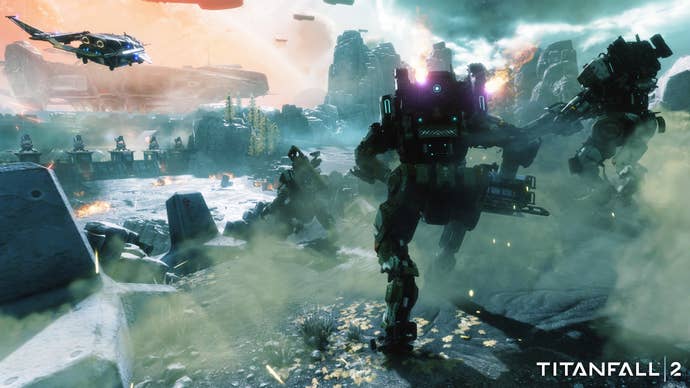
The power source is located deep inside the wrecked ship, and once found, BT is put on a path to recovery – but it's still not quite enough to bring him up to full operational functionality. He needs a second battery, and this time it's situated beyond a nearby IMC encampment. Cooper sees his first real combat action as he attempts to infiltrate the enemy base and single-handedly take out its small force of defenders. He can do this a couple of different ways, either by employing his cloaking shield to make himself invisible so he can sneak around, dispatching enemies using lethal takedowns, or he can simply go in guns blazing. Lacking any kind of subtlety, I chose the latter option, setting off an entertaining firefight that had me slowly working my way around the camp, picking off the opposition.
With the second power source found, BT is finally ready for action – and Cooper is rewarded with his first proper ride in a titan. He barely has time to get his bearings before enemy forces intercept him, setting off a fairly straightforward titan versus titan battle. Like the two set pieces before it, this is essentially a nicely integrated training mode, this time enabling the player to get used to piloting a titan in combat, which, along with platforming and shooting, forms the three major gameplay components of the campaign.
The action then ratchets up as BT and Cooper run into a major obstacle and have to go their separate ways, setting off a lengthy trek for Cooper that eventually leads to a massive, maze-like factory that's filled with giant machines and enemy soldiers. Cooper has to use all the moves in his repertoire to navigate through the facility, crossing bottomless pits by leaping from one piece of moving machinery to another, and engaging enemy IMC forces that are situated on platforms and gantries. It's really exciting, with some crazy jumps required to progress, and some great multi-level shoot-outs.
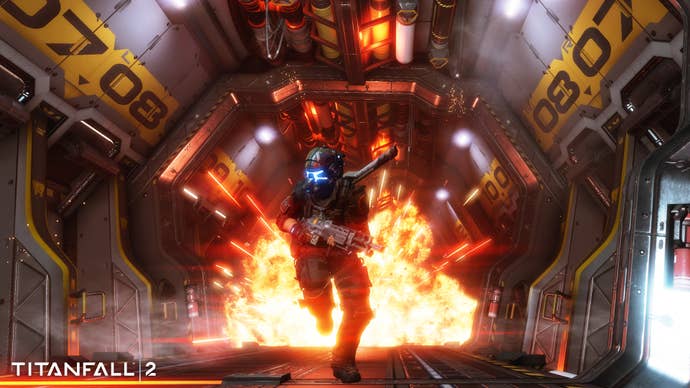
The deeper Cooper travels into the facility, the more he discovers about its true nature, and in the process uncovers a diabolical IMC plot that has serious ramifications for the very survival of the Frontier Militia. This basically sets up the rest of the campaign's story, which comprises a series of increasingly gripping and intense set pieces featuring titan battles, titan versus titan boss encounters, platform puzzling, and, of course, plenty of FPS combat.
Although the campaign isn't particularly long at around six-or-so hours, it's a quality experience in terms of its gameplay and general design. Presentation-wise, it's a little oldschool. There are a few cutscenes in the game, all seemingly involving in-game graphics, and while they're generally good, they're by no means cutting edge. That, combined with the fact that transitions between the campaign's nine distinct acts are simple text-and-picture screens, result in Titanfall 2 having a bit of a low-budget feel. But while the production values do come across as a little B-movie like, the voice acting and story are both top-notch.
Throughout the campaign, there are moments when Cooper talks to BT, with the player selecting what to say from a choice of two phrases. The outcome of the decision doesn't change the story in any way, but it does add a little depth and personality to the characters, while also helping articulate the bond that builds between man and machine as the game progresses. Some pieces of dialog are quite funny, and add welcome moments of levity to the proceedings.
But really, it's the action where Titanfall 2's campaign shines brightest. The game could so easily have been a straightforward first-person shooting gallery, but it's much more than that: A mash-up of platformer, arcade adventure, and shooter that mixes and matches the genres very well. The platforming sections make very good use of Titanfall 2's excellent movement system as you double-jump and wall-run around the imaginatively designed environments, trying not to fall foul of the many hazards that lie therein. Most of the platforming isn't exactly taxing – anyone with moderate skills should have no problem succeeding – but it is creative and inventive, and very satisfying to play through.

My favorite aspect of the game, however, is its gunplay. Respawn have incorporated a very interesting and varied cache of weapons into the game, and that variety isn't just about the difference between shotguns, sub machine guns, assault rifles, sniper rifles, and light machine guns – it's about the different types of shotguns, sub machine guns, and so on. Each weapon has its own distinct feel and trigger action that makes it unique. Sure, that difference can sometimes be subtle, but it's there, and I can think of few other games that feature this level of gunplay detailing. It essentially gives many of the weapons character – and consequently makes sampling them an interesting and thoroughly enjoyable experience as you figure out which ones work for your style of play, and which ones don't.
Of course, great gunplay wouldn't be worth a damn without great shooting segments, and to that end Titanfall 2's campaign doesn't disappoint. For the most part, the game relies on squads of fairly intelligent enemies to challenge the player, rather than sheer overwhelming force, and that makes for shootouts that feel very tight and compelling. It's all about outwitting and outmaneuvering the opposition, rather than just mowing them down, and that gives the action a touch of finesse.

Titan battles run along similar lines. They're used fairly sparingly, so they feel like high points of the campaign when they do occur. Some take the form of mech versus mech boss battles that are quite thrilling; especially on higher difficulty settings where you need to dodge and dash to stay out of the enemy line of fire. BT has ten different weapon loadouts, and like the guns in the game, each has its own unique style. I found I switched between them quite regularly, depending on the circumstances, which added to the fight dynamics.
Ultimately, Titanfall 2's campaign is a winner. Its production values might be a little oldschool, and it might be a little on the short side, but its action packs sufficient variety and interest to make the overall experience feel far more substantial than its running time might lead you to believe. The pacing is particularly effective, and the campaign builds in intensity throughout its duration to reach a really satisfying crescendo. Indeed, having played through it once already at a review event, I'm looking forward to working through it again on my own time – something that I normally wouldn’t consider doing for most FPS single-player campaigns. That's high praise coming from me.
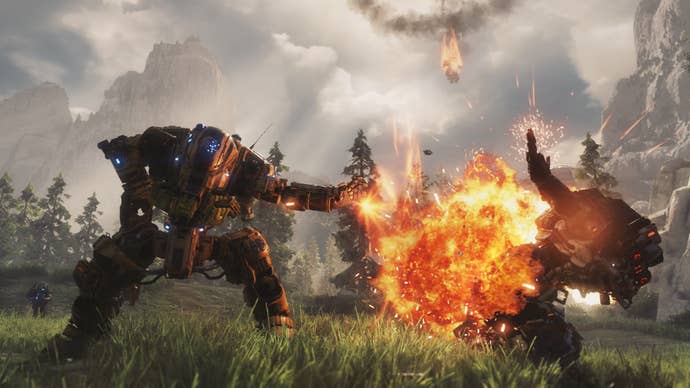
MULTIPLAYER
Titanfall 2's multiplayer aspect is deeper than its predecessor, and features seven modes: Skirmish, Attrition, Bounty Hunt, Pilot vs. Pilot, Last Titan Standing, Amped Hardpoint, and Capture the Flag.
Skirmish is the equivalent of Team Deathmatch, where two groups of six battle it out for points. Titans are earned over time, which is accelerated by contributing to your team's score. Attrition is similar to Skirmish, but includes squads of NPCs, such as grunts and specters, which are dropped into the fray at regular intervals and can be eliminated for bonus points.
Bounty Hunt takes the basic gameplay of Attrition and adds a twist where you earn money instead of points for eliminating targets, including AI titans. Every so often, bank nodes are activated across the map where you can drop off the cash you've earned, adding to your team's total score. If you're eliminated while carrying cash, you lose half of it to whoever killed you. Pilot vs. Pilot is a straightforward eight versus eight Team Deathmatch-style contest that doesn't include titans or NPCs, while Last Titan Standing pits teams of five against one another where everybody starts out in a titan. Each player only has one life, and the objective is to take down every titan on the opposing team.
Amped Hardpoint is basically a Domination-style game where players attempt to capture and control the three nodes on the map. In this particular version, standing next to a node captures it as normal, but if you continue to remain within its presence, it eventually "amps" and scores double points. Finally, Capture the Flag needs little explanation: Two teams of five attempt to collect the enemy flag, and deliver it to their base to score points.
The fundamental structure of Titanfall 2's multiplayer is similar to other games of this ilk: The player garners experience in combat that levels them up, earning them new weapons and perks in the process. Adding further depth is the fact that weapons also level up when you use them, which unlocks new attachments and weapon-specific perks. The same goes for Titans – the more you use them, the more new features can be accessed. There are also a huge variety of weapon, titan, and player skins to earn, along with banners and patches.
While it's not exactly original, Titanfall 2's multiplayer is nevertheless very well executed. Like in Titanfall, the controls dovetail beautifully with your intentions to enable you to navigate through the game's environments in spectacular fashion – especially when you use the standard moves in conjunction with the grappling hook. Further enhancing the game's feel is its superb gunplay. Like the single-player campaign, there's a very broad selection of weapons to choose from that deliver pretty much any kind of loadout playstyle you can conceive of. Whether you want to run-and-gun with a devastating shotgun, take a more considered, mid-range approach with an assault rifle, or provide long-range assistance with a sniper weapon or LMG, the game has you covered.
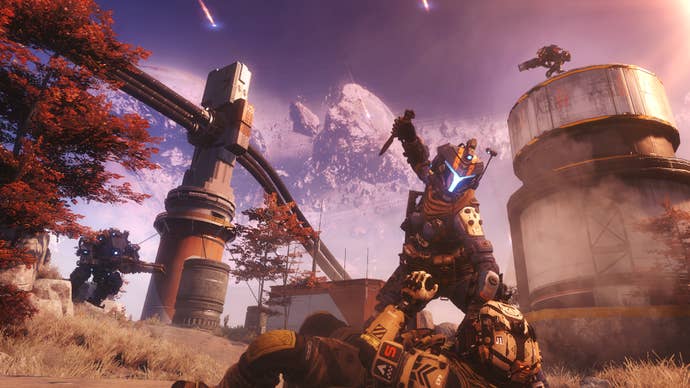
Titans continue to be a standout feature of the game. This time out, there are six different types, each with its own unique loadout and playstyle. They all feel powerful on the battlefield, and titan versus titan combat is exciting and intense – especially in the Last Titan Standing mode. Pilot versus titan combat has been tweaked slightly: Rodeoing one now results in you removing one of its batteries, which reduces its shielding. Subsequent attempts to rodeo it drops a grenade into its empty power outlet, which does fairly significant damage, but doesn't kill it outright unless its shields are down. Incidentally, stolen enemy titan batteries can be inserted into a friendly titan by clambering aboard, which restores its shield.
Titanfall 2's expansive maps are quite varied in their design and general layout. Forward Base Kodai and Complex are examples of a flatter, more labyrinthine approach; the former features a tightly grouped set of structures under one large roof, while the latter is a warren of building interiors and open spaces connected by pathways. Crash Site feels more confined and claustrophobic, with the action channeled down narrow canyon corridors, while Homestead takes an almost opposite tack, with wide open areas and plenty of room for mid- to long-range encounters. Eden, Black Canal, and Boomtown are all urban landscapes that incorporate a mixture of roadways and multi-level buildings. They offer more of an opportunity for using the game's verticality than the other maps, and the latter two also feature tight choke points that help concentrate conflict in the center of the map – especially in modes like Amped Hardpoint.
Overall, I think Titanfall 2's landscaping is excellent. The maps don't feel formulaic at all, and each has its own distinct style that helps vary the action greatly. One minute you can be battling from room to room though a tight, factory-like complex, and the next you're in a titan, engaging the enemy in open fields where there are just a few trees impeding your view. Few other multiplayer FPS games come close to offering that kind of combat variety.
However, while the maps are great, there just aren't quite enough of them. The good news is that new maps and modes will be added to the game over time, and they'll be free, but as it stands, Titanfall 2 maps roster feels a little light at launch.
That one complaint aside, I really like Titanfall 2's multiplayer. Its controls and gunplay are simply outstanding; they have a lightness and deftness that puts everything else into the shade. Couple that with the excellent playgrounds that Respawn have created, and you have a fast, kinetic, thoroughly engrossing shooter that offers many, many hours of potential entertainment.
Disclosure: Titanfall 2 was reviewed at a two-day event in Los Angeles. Airfare and hotel was covered by Electronic Arts.
InterfaceVery simple, functional, and straightforward. So much so that it feels almost plain.
SoundThroughout the campaign, the sound effects are absolutely outstanding. A special mention needs to go to the factory level, which sounds incredible.
VisualsWhile the graphics aren't quite cutting edge, they're plenty good enough.
ConclusionAlthough it's a little on the short side, and its production values are a bit oldschool, Titanfall 2's single-player campaign is a really enjoyable experience while it lasts. It's very inventive and fun, and a great warm-up for the game's excellent multiplayer component, whose gunplay and controls are absolutely outstanding. All it needs is a few more maps and modes.



